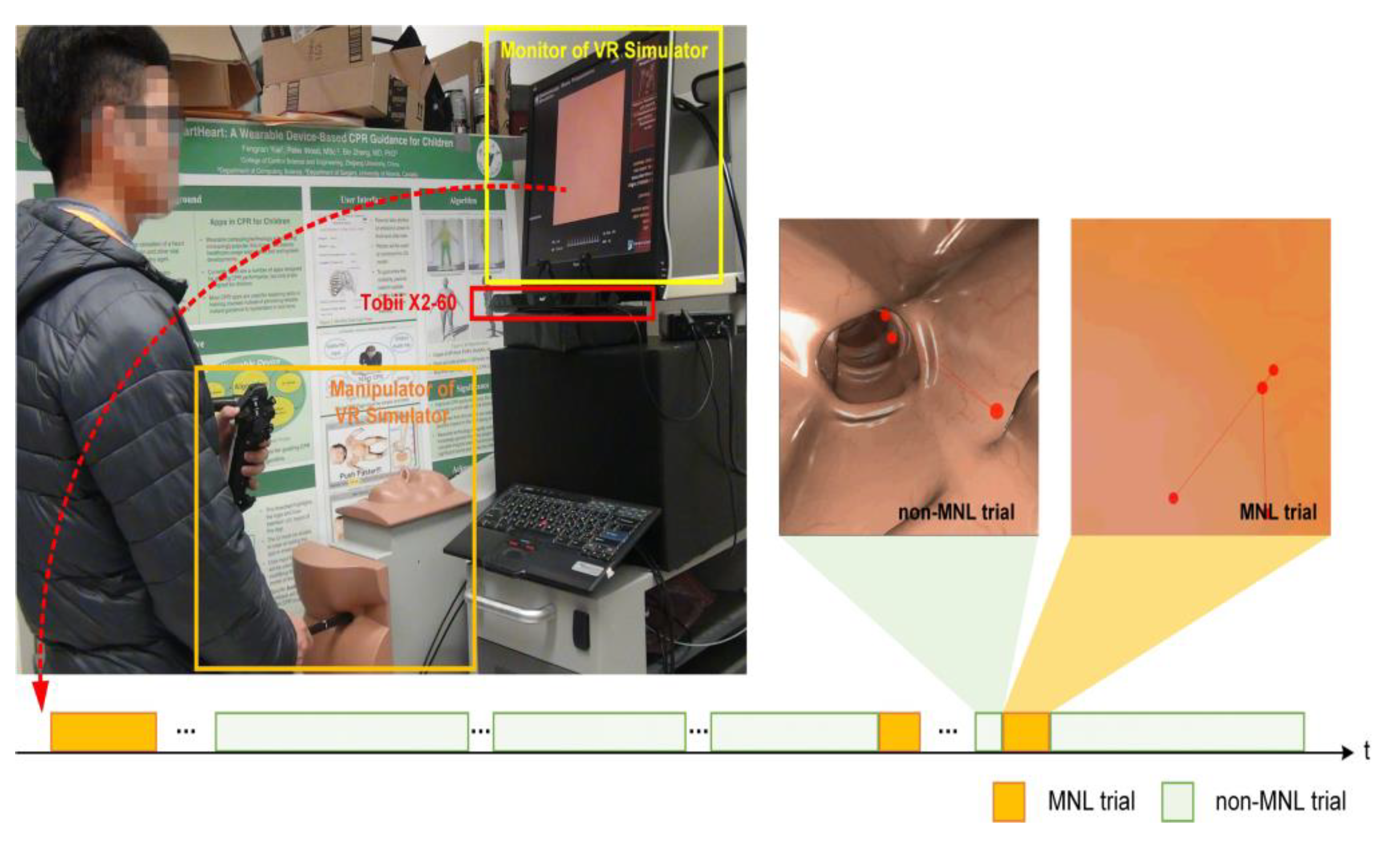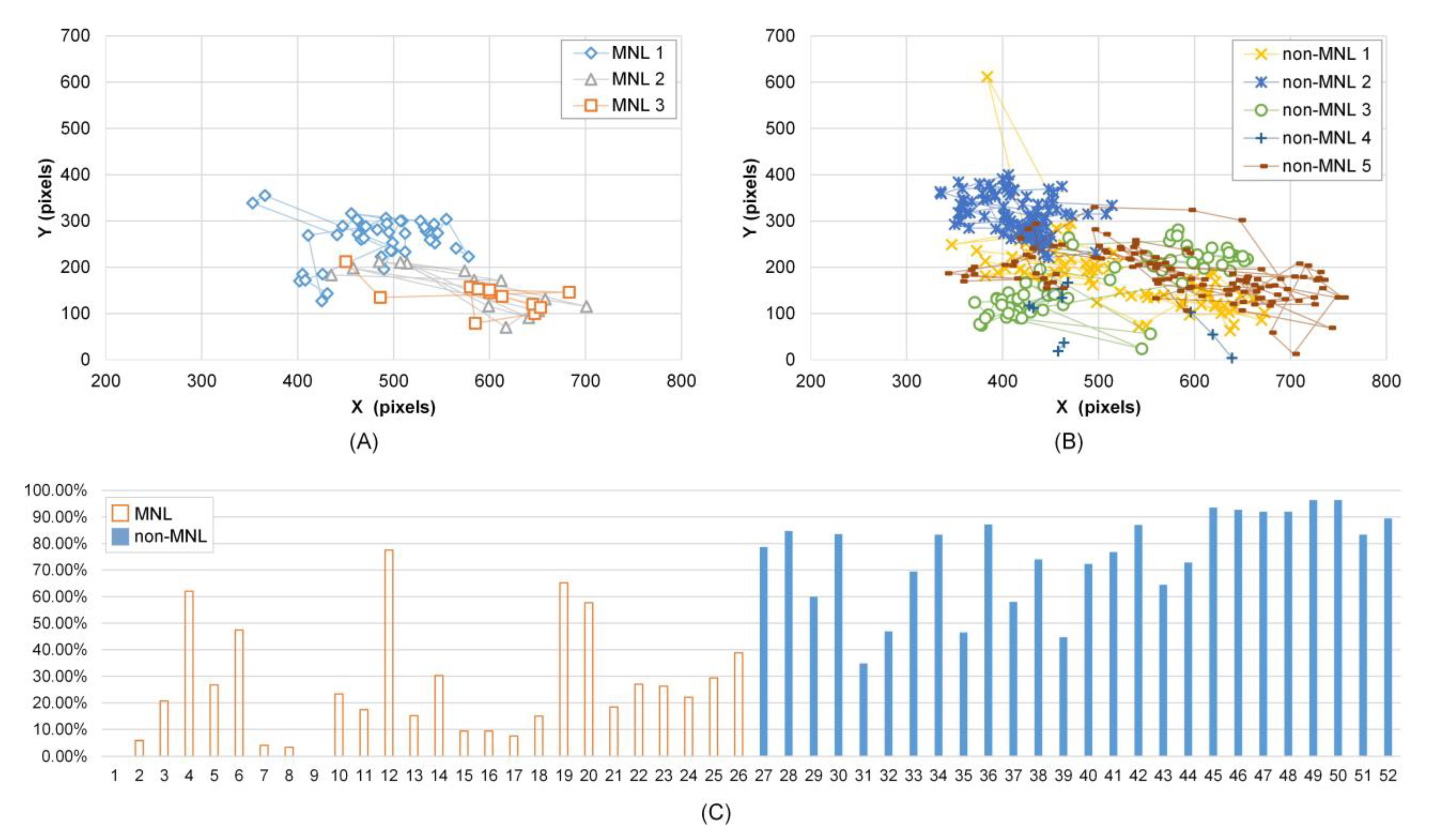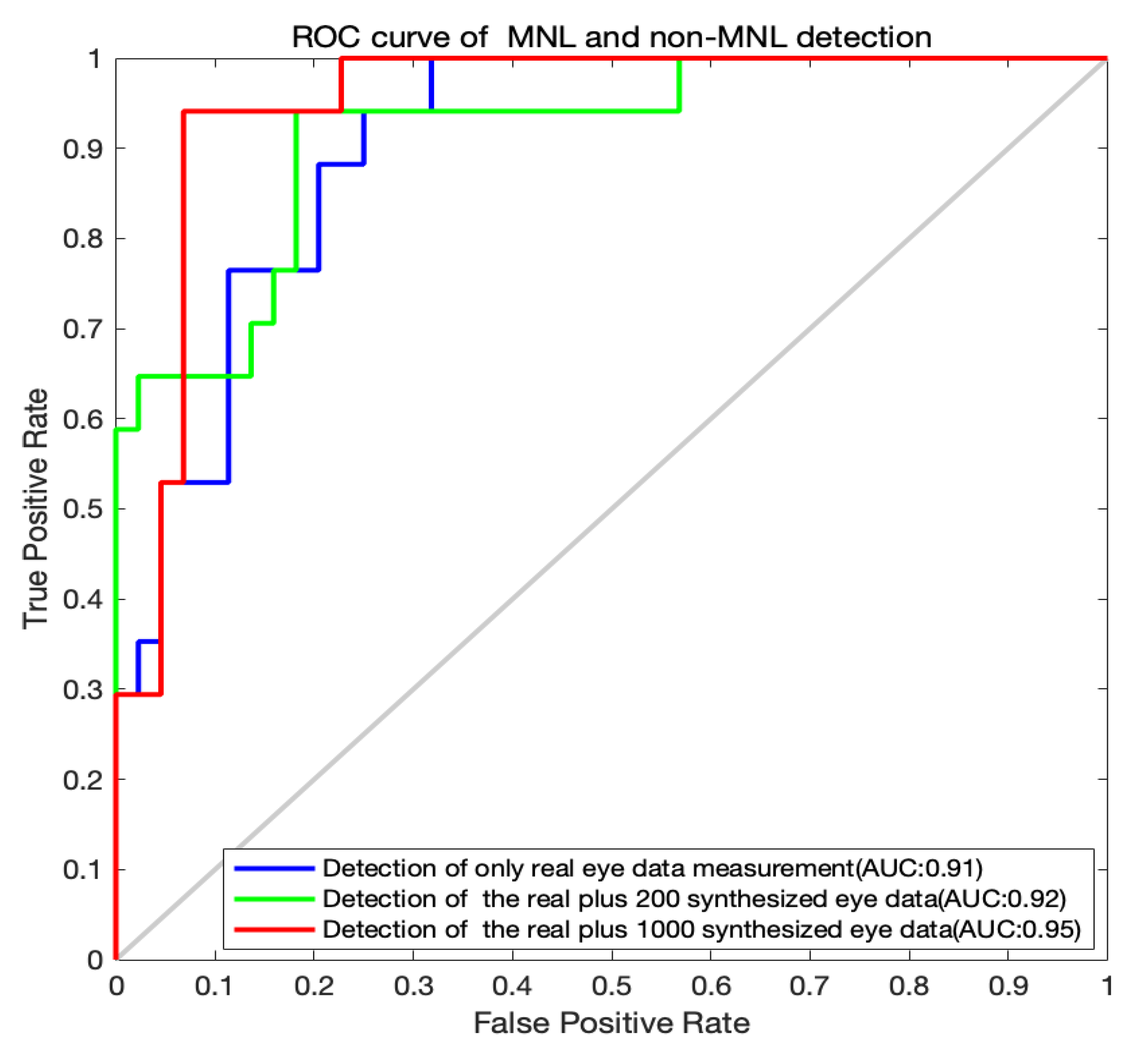Detecting Task Difficulty of Learners in Colonoscopy: Evidence from Eye-Tracking
Abstract
:Introduction
Methods
Participants
Tasks
Data Collection
Data Extraction
Eye gaze measures
Saccadic amplitude
Euclidean distance between fixations
Pupil size
Statistical Analysis
Deep Learning
Feature selection
Training process
Validation
Results
Eye Gaze Difference
Time and frequency in saccade and fixation
Saccade amplitude
Fixation distance
Pupil size
Intelligent Classification
Feature selection
Validity of synthesized data points
MNL and non-MNL classification
Discussion
Conclusions
Ethics and Conflict of Interest
Acknowledgments
References
- Allen, J. I. 2012. Quality assurance for gastrointestinal endoscopy. Curr Opin Gastroenterol 28, 5: 442–450. [Google Scholar] [CrossRef] [PubMed]
- Ben-Cohen, A., E. Klang, S. P. Raskin, S. Soffer, S. Ben-Haim, E. Konen, …, and H. Greenspan. 2019. Cross-modality synthesis from CT to PET using FCN and GAN networks for improved automated lesion detection. Engineering Applications of Artificial Intelligence 78: 186–194. [Google Scholar] [CrossRef]
- Biondi, F. N., B. Balasingam, and P. Ayare. 2020. On the Cost of Detection Response Task Performance on Cognitive Load. Human Factors. [Google Scholar] [CrossRef]
- Boyle, E., M. Al-Akash, S. Patchett, O. Traynor, and D. McNamara. 2012. Towards continuous improvement of endoscopy standards: validation of a colonoscopy assessment form. Colorectal Disease 14, 9: 1126–1131. [Google Scholar] [CrossRef] [PubMed]
- Committee, A. T., S. Varadarajulu, S. Banerjee, B. A. Barth, D. J. Desilets, V. Kaul, …, and S. A. Rodriguez. 2011. GI endoscopes. Gastrointestinal Endoscopy 74, 1: 1–6 e6. [Google Scholar] [CrossRef]
- Dimitriadis, G., J. P. Neto, and A. R. Kampff. 2018. t-SNE Visualization of Large-Scale Neural Recordings. Neural Computation 30, 7: 1750–1774. [Google Scholar] [CrossRef]
- Dolay, K., and M. Hasbahceci. 2017. The role of surgeons on the development and performance of endoscopy . Turkish Journal of Surgery 33, 1: 1–4. [Google Scholar] [CrossRef]
- Dube, C., and A. Rostom. 2016. Acquiring and maintaining competency in gastrointestinal endoscopy. Best Practice & Research in Clinical Gastroenterology 30, 3: 339–347. [Google Scholar] [CrossRef]
- Ekkelenkamp, V. E., A. D. Koch, R. A. de Man, and E. J. Kuipers. 2016. Training and competence assessment in GI endoscopy: a systematic review. Gut 65, 4: 607–615. [Google Scholar] [CrossRef]
- Hammond, J. S., N. F. S. Watson, J. N. Lund, and J. R. Barton. 2013. Surgical endoscopy training: the Joint Advisory Group on gastrointestinal endoscopy national review. Frontline Gastroenterol 4, 1: 20–24. [Google Scholar] [CrossRef]
- He, W. J., S. Bryns, K. Kroeker, A. Basu, D. Birch, and B. Zheng. 2020. Eye gaze of endoscopists during simulated colonoscopy. Journal of Robotic Surgery 14, 1: 137–143. [Google Scholar] [CrossRef]
- Henneman, E. A., J. L. Marquard, D. L. Fisher, and A. Gawlinski. 2017. A Novel Approach for Evaluating and Improving the Safety of Healthcare Processes in the Simulated Setting. Simulation in Healthcare-Journal of the Society for Simulation in Healthcare 12, 1: 51–56. [Google Scholar] [CrossRef]
- Hou, B. R., J. Y. Yang, P. Wang, and R. Q. Yan. 2020. LSTM-Based Auto-Encoder Model for ECG Arrhythmias Classification. Ieee Transactions on Instrumentation and Measurement 69, 4: 1232–1240. [Google Scholar] [CrossRef]
- Jirapinyo, P., A. B. Imaeda, and C. C. Thompson. 2015. Endoscopic training in gastroenterology fellowship: adherence to core curriculum guidelines. Surgical Endoscopy and Other Interventional Techniques 29, 12: 3570–3578. [Google Scholar] [CrossRef] [PubMed]
- Karen Palmer, M. T., and Bournes Debra. 2017. Colorectal cancer screening can save lives-so why don't more Canadians do it? Retrieved. Retrieved from https://healthydebate.ca/2017/06/topic/colorectal-cancer-screening-colonoscopy/.
- Karim, F., S. Majumdar, and H. Darabi. 2019. Insights Into LSTM Fully Convolutional Networks for Time Series Classification. Ieee Access 7: 67718–67725. [Google Scholar] [CrossRef]
- Lu, S., Y. P. Sanchez Perdomo, X. Jiang, and B. Zheng. 2020. Integrating Eye-Tracking to Augmented Reality System for Surgical Training. Journal of Medical Systems 44, 11: 192. [Google Scholar] [CrossRef]
- Luning, T. H., M. E. Keemers-Gels, W. B. Barendregt, A. C. Tan, and C. Rosman. 2007. Colonoscopic perforations: a review of 30,366 patients. Surgical Endoscopy and Other Interventional Techniques 21, 6: 994–997. [Google Scholar] [CrossRef] [PubMed]
- Mathôt, S. 2018. Pupillometry: Psychology, Physiology, and Function. J Cogn 1, 1: 16. [Google Scholar] [CrossRef]
- Michielli, N., U. R. Acharya, and F. Molinari. 2019. Cascaded LSTM recurrent neural network for automated sleep stage classification using single-channel EEG signals. Computers in Biology and Medicine 106, 71–81. [Google Scholar] [CrossRef]
- Moore, L. E. 2003. The advantages and disadvantages of endoscopy. Clin Tech Small Anim Pract 18, 4: 250–253. [Google Scholar] [CrossRef]
- Nerup, N., L. Preisler, M. B. S. Svendsen, L. B. Svendsen, and L. Konge. 2015. Assessment of colonoscopy by use of magnetic endoscopic imaging: design and validation of an automated tool. Gastrointestinal Endoscopy 81, 3: 548–554. [Google Scholar] [CrossRef]
- Pollastri, F., F. Bolelli, R. Paredes, and C. Grana. 2020. Augmenting data with GANs to segment melanoma skin lesions. Multimedia Tools and Applications 79, 21-22: 15575–15592. [Google Scholar] [CrossRef]
- Rabeneck, L., L. F. Paszat, R. J. Hilsden, R. Saskin, D. Leddin, E. Grunfeld, …, and T. A. Stukeli. 2008. Bleeding and Perforation After Outpatient Colonoscopy and Their Risk Factors in Usual Clinical Practice. Gastroenterology 135, 6: 1899–1906. [Google Scholar] [CrossRef]
- Radford, A., L. Metz, and S. Chintala. 2016. Unsupervised Representation Learning with Deep Convolutional Generative Adversarial Networks (Publication no. arXiv:1511.06434v2). [Google Scholar]
- Salehinejad, H., E. Colak, T. Dowdell, J. Barfett, and S. Valaee. 2019. Synthesizing Chest X-Ray Pathology for Training Deep Convolutional Neural Networks. Ieee Transactions on Medical Imaging 38, 5: 1197–1206. [Google Scholar] [CrossRef] [PubMed]
- Salvucci, D. D., and J. H. Goldberg. 2000. Identifying fixations and saccades in eye-tracking protocols. Paper presented at the Proceedings of the 2000 symposium on Eye tracking research & applications, Palm Beach Gardens, Florida, USA. [Google Scholar]
- Siau, K., J. Hodson, R. M. Valori, S. T. Ward, and P. Dunckley. 2019. Performance indicators in colonoscopy after certification for independent practice: outcomes and predictors of competence. Gastrointestinal Endoscopy 89, 3: 482–+. [Google Scholar] [CrossRef] [PubMed]
- Skubleny, D., N. Switzer, S. Karmali, and C. de Gara. 2015. Endoscopy services and training: a national survey of general surgeons. Canadian Journal of Surgery 58, 5: 330–334. [Google Scholar] [CrossRef]
- Subhas, G., T. Mugwisi, and V. K. Mittal. 2017. Effect of Changing Patterns and Requirements of Endoscopic Training in Surgical Residency. International Surgery 102, 3-4: 184–188. [Google Scholar] [CrossRef]
- Swanstrom, L., and B. Zheng. 2008. Spatial orientation and off-axis challenges for NOTES. Gastrointest Endosc Clin N Am 18, 2: 315–324. [Google Scholar] [CrossRef] [PubMed]
- van der Maaten, L., and G. Hinton. 2008. Visualizing Data using t-SNE. Journal of Machine Learning Research 9: 2579–2605, Retrieved from <Go to ISI>://WOS:000262637600007. [Google Scholar]
- Xie, Y., R. Y. Liang, Z. L. Liang, C. W. Huang, C. R. Zou, and B. Schuller. 2019. Speech Emotion Classification Using Attention-Based LSTM. Ieee-Acm Transactions on Audio Speech and Language Processing 27, 11: 1675–1685. [Google Scholar] [CrossRef]
- Zanini, R. A., and E. L. Colombini. 2020. Parkinson's Disease EMG Data Augmentation and Simulation with DCGANs and Style Transfer. Sensors 20, 9. [Google Scholar] [CrossRef]
- Zheng, B., X. Jiang, and M. S. Atkins. 2015. Detection of Changes in Surgical Difficulty: Evidence From Pupil Responses. Surg Innov 22, 6: 629–635. [Google Scholar] [CrossRef]
- Zhu, J. P., H. Q. Chen, and W. B. Ye. 2020. A Hybrid CNN-LSTM Network for the Classification of Human Activities Based on Micro-Doppler Radar. Ieee Access 8: 24713–24720. [Google Scholar] [CrossRef]





| Parameters | MNL | non-MNL | P-value |
|---|---|---|---|
| Mean ± SE | Mean ± SE | ||
| phase duration (s) | 12.53 ± 1.45 | 22.97 ± 2.01 | < 0.001 |
| saccade duration (s) | 5.49 ± 1.00 | 10.78 ± 1.44 | 0.003 |
| saccade number | 52.06 ± 7.91 | 101.19 ± 9.36 | < 0.001 |
| fixation number | 23.69 ± 2.77 | 40.94 ± 3.89 | < 0.001 |
| saccade frequency (#/s) | 4.29 ± 0.26 | 4.60 ± 0.18 | 0.329 |
| fixation frequency (#/s) | 2.04 ± 0.08 | 1.95 ± 0.08 | 0.406 |
| gaze event frequency (#/s) | 6.34 ± 0.28 | 6.55 ± 0.20 | 0.530 |
| mean duration of saccade for each time (s) | 0.10 ± 0.00 | 0.09 ± 0.00 | 0.474 |
| mean duration of fixation for each time (s) | 0.30 ± 0.02 | 0.28 ± 0.01 | 0.490 |
| saccade duration percent (%) | 41.19 ± 3.07 | 44.10 ± 2.91 | 0.506 |
| saccade number percent (%) | 65.36 ± 1.51 | 68.91 ± 1.31 | 0.082 |
| fixation number percent (%) | 34.64 ± 1.51 | 31.09 ± 1.31 | 0.082 |
| Parameters | MNL | non-MNL | Diff. of Mean | P-value |
|---|---|---|---|---|
| Mean ± SE | Mean ± SE | |||
| FixDis in [0,25] pixels (%) | 29.05 ± 2.61 | 43.22 ± 2.33 | -14.18 | < 0.001 |
| FixDis in [0,50] pixels (%) | 48.70 ± 3.28 | 66.67 ± 2.22 | -17.97 | < 0.001 |
| FixDis in [0,75] pixels (%) | 63.60 ± 3.02 | 82.53 ± 1.68 | -18.92 | < 0.001 |
| FixDis in [0,100] pixels (%) | 75.80 ± 2.89 | 90.35 ± 1.22 | -14.56 | < 0.001 |
| SacAmp (degrees) | 2.48 ± 0.19 | 1.45 ± 0.08 | - | < 0.001 |
| SacAmp > 1.5° (%) | 61.38 ± 2.98 | 44.13 ± 2.29 | 17.26 | < 0.001 |
| SacAmp > 2.0° (%) | 54.22 ± 2.96 | 34.41 ± 2.17 | 19.82 | < 0.001 |
| SacAmp > 2.5° (%) | 46.60 ± 2.96 | 25.12 ± 1.83 | 21.48 | < 0.001 |
| SacAmp > 3.0° (%) | 39.26 ± 2.84 | 19.33 ± 1.62 | 19.93 | < 0.001 |
| SacAmp > 3.5° (%) | 32.17 ± 2.66 | 14.08 ± 1.36 | 18.09 | < 0.001 |
| SacAmp > 4.0° (%) | 25.33 ± 2.71 | 11.14 ± 1.16 | 14.19 | < 0.001 |
| SacAmp > 4.5° (%) | 21.66 ± 2.37 | 8.36 ± 1.11 | 13.29 | < 0.001 |
| SacAmp > 5.0° (%) | 18.78 ± 2.27 | 6.48 ± 0.95 | 12.30 | < 0.001 |
| SacAmp > 5.5° (%) | 16.17 ± 2.01 | 5.01 ± 0.83 | 11.15 | < 0.001 |
| SacAmp > 6.0° (%) | 12.99 ± 1.86 | 4.15 ± 0.81 | 8.84 | < 0.001 |
| SacAmp > 6.5° (%) | 11.91 ± 1.73 | 3.65 ± 0.78 | 8.25 | < 0.001 |
| SacAmp > 7.0° (%) | 11.03 ± 1.69 | 2.69 ± 0.64 | 8.33 | < 0.001 |
| SacAmp > 7.5° (%) | 9.84 ± 1.62 | 2.03 ± 0.54 | 7.81 | < 0.001 |
| Parameters | MNL | non-MNL | P-value | |
|---|---|---|---|---|
| Mean ± SE | Mean ± SE | |||
| APS of left eye in trial (%) | 46.96 ± 1.54 | 64.38 ± 1.43 | < 0.001 | |
| APS of right eye in trial (%) | 46.99 ± 1.45 | 62.52 ± 1.60 | < 0.001 | |
| APS of left eye in saccade (%) | 46.22 ± 1.52 | 63.50 ± 1.49 | < 0.001 | |
| APS of right eye in saccade (%) | 46.80 ± 1.41 | 61.75 ± 1.63 | < 0.001 | |
| APS of left eye in fixation (%) | 47.61 ± 1.58 | 65.16 ± 1.39 | < 0.001 | |
| APS of right eye in fixation (%) | 47.28 ± 1.47 | 63.31 ± 1.60 | < 0.001 | |
| cumulative frequency of APS in [55%,100%] (left eye) (%) | 25.88 ± 4.03 | 72.07 ± 3.21 | < 0.001 | |
| cumulative frequency of APS in [55%,100%] (right eye) (%) | 26.53 ± 3.80 | 68.01 ± 3.45 | < 0.001 | |
| index of maximum cumulative frequency of APS (left eye) | 10.05 ± 0.33 | 13.71 ± 0.31 | < 0.001 | |
| index of maximum cumulative frequency of APS (right eye) | 9.93 ± 0.33 | 13.43 ± 0.36 | < 0.001 | |
| Training Set | Test Set | Accuracy | Sensitivity | Specificity |
|---|---|---|---|---|
| MNL: 51 (R) non-MNL: 77(R) | MNL: 17(R) non-MNL: 44(R) | 81.96% | 79.55% | 88.24% |
| MNL:51(R)+200(S) non-MNL: 77(R)+200(S) | 83.61% | 79.55% | 94.12% | |
| MNL: 51(R)+1000(S) non-MNL: 77(R)+1000(S) | 91.80% | 90.91% | 94.12% | |
| MNL: 51(R)+1600(S) non-MNL: 77(R)+1600(S) | 88.52% | 95.45% | 70.59% | |
| MNL: 51(R)+2000(S) non-MNL: 77(R)+2000(S) | 83.61% | 86.36% | 76.47% |
Copyright © 2021. This article is licensed under a Creative Commons Attribution 4.0 International License.
Share and Cite
Xin, L.; Bin, Z.; Xiaoqin, D.; Wenjing, H.; Yuandong, L.; Jinyu, Z.; Chen, Z.; Lin, W. Detecting Task Difficulty of Learners in Colonoscopy: Evidence from Eye-Tracking. J. Eye Mov. Res. 2021, 14, 1-13. https://doi.org/10.16910/jemr.14.2.5
Xin L, Bin Z, Xiaoqin D, Wenjing H, Yuandong L, Jinyu Z, Chen Z, Lin W. Detecting Task Difficulty of Learners in Colonoscopy: Evidence from Eye-Tracking. Journal of Eye Movement Research. 2021; 14(2):1-13. https://doi.org/10.16910/jemr.14.2.5
Chicago/Turabian StyleXin, Liu, Zheng Bin, Duan Xiaoqin, He Wenjing, Li Yuandong, Zhao Jinyu, Zhao Chen, and Wang Lin. 2021. "Detecting Task Difficulty of Learners in Colonoscopy: Evidence from Eye-Tracking" Journal of Eye Movement Research 14, no. 2: 1-13. https://doi.org/10.16910/jemr.14.2.5
APA StyleXin, L., Bin, Z., Xiaoqin, D., Wenjing, H., Yuandong, L., Jinyu, Z., Chen, Z., & Lin, W. (2021). Detecting Task Difficulty of Learners in Colonoscopy: Evidence from Eye-Tracking. Journal of Eye Movement Research, 14(2), 1-13. https://doi.org/10.16910/jemr.14.2.5



